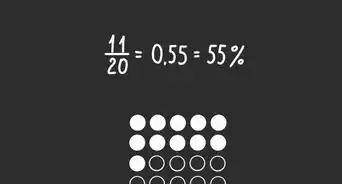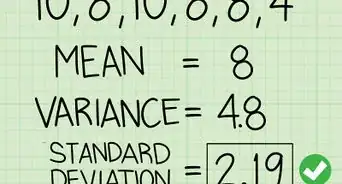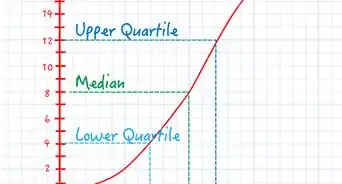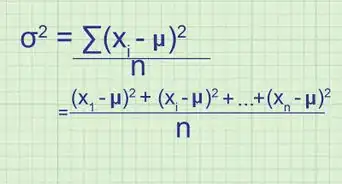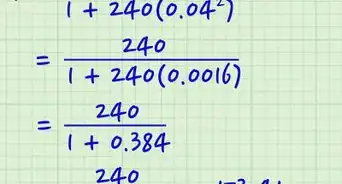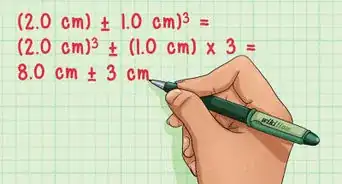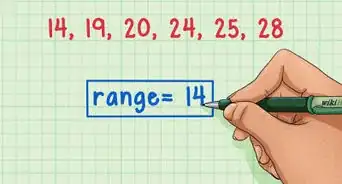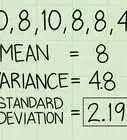This article was co-authored by wikiHow Staff. Our trained team of editors and researchers validate articles for accuracy and comprehensiveness. wikiHow's Content Management Team carefully monitors the work from our editorial staff to ensure that each article is backed by trusted research and meets our high quality standards.
This article has been viewed 493,751 times.
Learn more...
In working with data, there are several different ways to measure how closely grouped your data values are. The most common is the mean. Most people learn early in school to calculate the mean by finding the sum of a group of data values and then dividing by the number of values in the set. A more advanced calculation is the mean deviation about the mean. This calculation tells you how close to the mean your values are. Finding this consists of finding the mean for a data set, finding the difference of each data point from that mean, and then taking the mean of those differences.
Steps
Calculating the Mean
-
1Collect and count your data. For any set of data values, the mean is a measure of central value. Depending on the type of data, the mean tells you the central value of that data. To find the mean, you must first collect your data, either through an experiment of some sort or just from an assigned problem.[1]
- For this example, use the assigned data set of 6, 7, 10, 12, 13, 4, 8 and 12. This set is small enough to count by hand to find that there are eight numbers in the set.
- In statistical work, the variable or is commonly used to represent the number of data values.
-
2Find the sum of the data values. The first step of finding the mean is calculating the sum of all the data points. In statistical notation, each value is generally represented by the variable . The sum of all values is symbolized as . The capital Greek letter sigma signifies finding the sum of the values. For this sample data set, the calculation is:[2]Advertisement
-
3Divide to find the mean. Finally, divide the sum by the number of values. The Greek letter mu, , is commonly used to represent the mean. Therefore, the calculation of the mean is:[3]
Finding the Mean Deviation
-
1Set up a table. To keep your data in good order and to help with the calculations, it is helpful to create a three-column table. Label the first column . Label the second column . Label the third column .[4]
- Fill the first column with the data points for your calculation.
-
2Calculate the deviation of each data point. In the second column, which you have labeled , you will report the deviation or difference between each data point and the mean of the set. Find this value simply by subtracting the mean from each data value.[5]
- For the sample data set, these deviations will be:
- To check the validity of your calculations, the sum of the values in this deviation column should be 0. If you add them up and get something other than 0, then either your mean is incorrect or you made an error in calculating one or more of the deviations. Go back and check your work.
- For the sample data set, these deviations will be:
-
3Find the absolute value of each deviation. When you calculate the deviation of each data point from the mean, you are concerned only with the size of the difference, and not whether the difference is positive or negative. What you really need, then, in mathematical terminology, is the absolute value of the difference. Absolute value is designated symbolically with the vertical bars | |.[6]
- Absolute value is a mathematical tool used to measure distance or size, regardless of direction.
- To find absolute value, just drop the negative sign from each number in the second column. Thus, fill the third column with the absolute values as follows:
-
4Calculate the mean of the absolute deviations. After completing your three-column table, find the mean of the absolute values in the third column. As you did to find the mean of the original data points, add the deviations together and divide the sum by the number of values.[7]
- For this data set, this final calculation will be:
- For this data set, this final calculation will be:
-
5Interpret the result. The value of the mean deviation about the mean is a measure of how closely grouped your data values are. It answers the question, “How close to the mean, on average, are the data values?” [8]
- For example, with this data set, you can say that the mean is 9 and the average distance from that mean is 2.75. Note that some numbers are closer than 2.75 and some are farther. But that is the average distance.
Community Q&A
-
QuestionWhat is the mean deviation of 4, 8, 5, 12, 23, 45, 8, 7?
 Ed RozmiarekCommunity AnswerAdd them together to get a mean of 14. Subtract each number minus 14 and find the absolute value of those differences: 10, 6, 9, 2, 9, 31, 6, 7. Find the mean of those deviations by dividing by 8.
Ed RozmiarekCommunity AnswerAdd them together to get a mean of 14. Subtract each number minus 14 and find the absolute value of those differences: 10, 6, 9, 2, 9, 31, 6, 7. Find the mean of those deviations by dividing by 8. -
QuestionWhat is the mean deviation of the set of data 7, 6, 3, 4, 10?
 Ed RozmiarekCommunity AnswerFind the mean: (7+6+3+4+10)/5 = 6. Find the absolute difference of each number from the mean. These are 1, 0, 3, 2, 4. Find the mean of these differences: (1+0+3+2+4)/5 = 2.
Ed RozmiarekCommunity AnswerFind the mean: (7+6+3+4+10)/5 = 6. Find the absolute difference of each number from the mean. These are 1, 0, 3, 2, 4. Find the mean of these differences: (1+0+3+2+4)/5 = 2. -
QuestionWhat is the mean deviation about the mean for the following data 1,3,7,9,10,12?
 Ed RozmiarekCommunity AnswerFind the mean: (1+3+7+9+10+12)/6=42/6=7 Find the deviation from the mean of each data point by subtracting each value minus the mean: -6, -4, 0, 2, 3, 5 Take the absolute values: 6, 4, 0, 2, 3, 5 Find the mean of the deviations: (6+4+0+2+3+5)/6=20/6=3.33.
Ed RozmiarekCommunity AnswerFind the mean: (1+3+7+9+10+12)/6=42/6=7 Find the deviation from the mean of each data point by subtracting each value minus the mean: -6, -4, 0, 2, 3, 5 Take the absolute values: 6, 4, 0, 2, 3, 5 Find the mean of the deviations: (6+4+0+2+3+5)/6=20/6=3.33.
References
- ↑ http://www.mathsisfun.com/definitions/mean.html
- ↑ https://www.mathsisfun.com/mean.html
- ↑ https://www.mathsisfun.com/mean.html
- ↑ http://www.mathsisfun.com/data/mean-deviation.html
- ↑ http://www.mathsisfun.com/data/mean-deviation.html
- ↑ https://www.mathsisfun.com/data/mean-deviation.html
- ↑ https://sciencing.com/absolute-deviation-average-absolute-deviation-4918826.html
- ↑ https://www.cuemath.com/mean-deviation-formula/
About This Article
To calculate mean deviation about mean for ungrouped data, start by finding the mean of your data set by adding all of the data points together and then dividing by the total number of points. Once you have the mean, calculate the deviation of each data point by subtracting the mean from each point. Then, drop the negative sign from any deviations that have them. Finally, calculate the mean of the deviations by adding them together and dividing by the total number of deviations. To see an example problem, keep reading!
-Step-1.webp)


-Step-2.webp)



-Step-3.webp)


-Step-4.webp)


-Step-5.webp)







-Step-6.webp)








-Step-7.webp)

-Step-8.webp)
